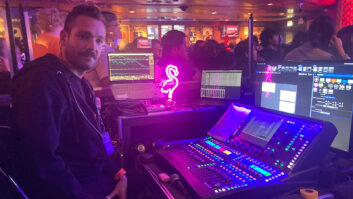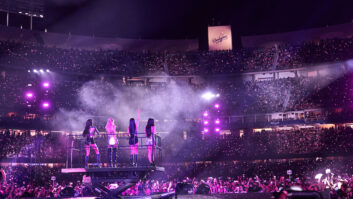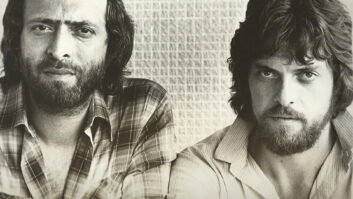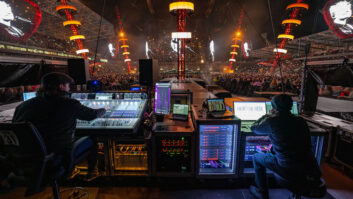
Alan Jackson is as prominent as ever on the Nashville charts withhis new album, High Mileage. He’s all over the tube in national Fordtruck commercials, and then there’s his tour that’s taking him acrossthe U.S. and Canada in the company of country siren Deana Carter.
Between August and the publication of this article, 80% of Carter’slive shows were slated to be on the same bill with Jackson. Whentraveling together, they are hard to miss out on the interstate. Fivetrucks move Jackson’s gear from town to town, while a single rigtransports Carter’s.
However, true to his traditionalist mind-set, when Jackson hits theriser and steps up to his Beta 58A vocal mic, it’s all about themusic-there are no gimmicks. As a natural foil to Jackson’s hard-corecountry sensibilities, Carter’s music rocks out with a completelydifferent energy of its own.
Carter opens each show, appearing onstage with brother Jeff Carteron guitars and vocals, Loretta Brank on fiddle, Paul Kramer on guitarsand mandolin, Steve Mackey on bass, keyboardist Vic White and drummerAngelo Collura.
Jackson kicks off his show with an electric set, followed by anacoustic set. Then he’s plugged back in for the third and final set,which features many of his mega-hits. From his place at center stagedown front, Jackson is backed from stage right to stage left by steelguitarist Robbie Flint, guitarist Danny Groah, utility player TomRutledge, drummer Bruce Rutherford, bassist Roger Wills, Mark McClurgon fiddle and Monty Parkey on keys. Pulling double duty, tour managerTony Stephens fills in on harp for some songs. Three video screensmanaged by Performance Video bring live close-ups of the onstage actionto the crowd, along with other clips of Jackson “visualbilia.”
Showco (represented on the tour by crew chief Kevin Gilpatric, GaryBrown and Wade Griffin) provides a Prism rig for both acts-eightcolumns per side in its standard configuration. As with most countrytours of this magnitude, the Jackson/Carter show has regularly playedwarm-weather venues ranging from state fairs to sheds, as well as thereverberant world of arenas.
Phil Somers, a seasoned vet who ran his own sound company andspecialized in big-name jazz accounts before moving to Nashville in1981, mixes Jackson on a Gamble EX-56 console. Monitor mixer ChuckYoung rides herd over a combination of Showco SRM wedges and FutureSonics in-ear systems.
Everyone on the Jackson/Carter tour seems completely affable andeasygoing. “There’s no time for attitudes,” Young points out. “This isNashville.” Somers and his “ready-for-anything-so-why-worry” work ethiceasily fall into the genial pace. Gain and tonality are among his mainFOH objectives, so Somers avoids automation and sets up routing so thathe can mix from the center section of the EX-56, where there are eightstereo groups.
“I basically maintain one stereo group per player,” Somers says. “SoI can pretty much pick up whatever instrument is playing in the centersection. The Gamble has very narrow modules, so it’s easier for me tostay in the center rather than trying to hop around grabbing at things.That way, I can concentrate on listening to the show rather than onlooking for the correct fader.”
During the course of a night’s work, Somers deals with a number ofcues and a good mixture of musical textures running the gamut from slowballads to up-tempo, high-energy hits. To manage the diverse nature ofthe show, a MIDI controller can access about ten reverb scenes. Somerskeeps a pair of AMS RMX-16 units in the effects rack for snare and tomon slower-tempo material and ballads. For up-tempo and mid-tempo songs,three Yamaha SPX 900 units are employed. The Lexicon 224 is the primaryvocal reverb.
Somers creates a rockabilly slap echo on vocals with a pair ofRoland SDE 3000 delays, while a BBE Sonic Maximizer adds a littledefinition to Jackson’s vocal in reverberant rooms.
Other “primary helpers” in the Somers FOH gallery are a pair ofApogee CRQ12 equalizers, which, along with providing main system EQ,add gain to Jackson’s vocal to compensate for his sometimes loudaudiences. Equalization from two Klark-Teknik DN-410s is applied tobackground vocals left and right, and to upright bass. IndustrialResearch TEQ DG-4023A EQ is included as a Jackson channel insert, aswell as for backing vocals and some main system EQ. Rounding out thelist is a contingent of Summit and dbx compressors for channel inserts,backing vocals, bass, fiddle and mandolin.
Overall, Somers has been given somewhat of a loose leash with hismix. “I had a discussion with Alan when I was hired in January of1996,” he relates. “And I asked him what he was looking for in hisaudio presentation. He essentially said he wanted good, intelligiblevocals and a sound that was oriented toward the style of his recordedmaterial. So I lean toward the album mixes, but we have differentplayers, so I try to add a live feeling by taking a few more libertieswith effects and other characteristics, which add spontaneity.”
Jackson prefers an onstage mix that “creates an intimate nightclubatmosphere for him, with studio quality,” monitor mixer Young explains.”In his early days, he developed a fondness for standing in that magicpocket within the band that is easy to find in the close quarters of anightclub stage. As he worked his way up into the studio, he quicklybegan to appreciate the sonic quality he got from his headphone mix.Today, my job is to bring him the qualities of both worlds in my livemix onstage, where all of this is at his disposal.”
Young mixes from a 52-channel Yamaha PM4000M console (Jackson andhis band, The Strayhorns, require a total of 20 monitor mixes). Poweris provided by Crown 36×12 amps, and a Showco “deep rack” allows 40spaces for, among other units, a Yamaha REV7 and SPX 900, as well as aLexicon PCM 80, which Young occasionally employs to “fatten up” leadguitarist Danny Groah’s Telecaster. BSS DPR-402 compressors are used onkick and snare, with a pair of DPR-504 4-channel gates. A dozen BSSVariCurve FCS-926 digital units are controlled remotely.
Ramsa S-5As cover the drum kit at rack and floor tom positions, witha B&K 4011 at kick. Sennheiser 409s pick up steel and lead guitarsdirectly at the amp. Jackson’s voice is captured by a Beta 58A, as areall other vocals, with the exception of drummer Bruce Rutherford, wholikes a Beta 56. DIs take care of acoustic guitar, fiddle, mandolin,piano (left-right), upright bass, banjo, synth and tic tac.
“When you’re singing in clubs, you’re going to sing into anSM58-that’s the standard,” says Young. “Alan got used to the mic there,and even to this day, it still simply lends itself to his voice. We’veupgraded to the Beta 58A just because it’s a little smoother and has alittle better rejection.”
Standing behind a band mix coming from two Showco SRM wedges,Jackson receives his vocal only from an outside pair of SRMs.Frontfills line the stage, and bass player Roger Wills uses a singlewedge in tandem with a single earpiece from a Future Sonics system.Other configurations range from stereo wedges to a Future Sonics earmix used by drummer Rutherford, augmented by a wedge mix and an 18-inchsub. Young directs multiple feeds to Rutherford, including one forears, another that arrives at a Mackie 16-channel mixer, and stereoleft and right of everything. “That way, he can take or leave whateverhe wants, whenever he wants,” Young says with the confidence of someonewho has all his bases covered.
SMOOTH TRANSITION A natural logistical consideration withdouble-bill acts is how to quickly manage set changes. “With theexception of our shared use of the Prism system, we are totallyseparate in every way,” notes Young. “So the Carter crew can tear downright after their show and load out during the set change. They areusually gone by the time we’re ready to get started with Alan. Thatmakes for an extremely smooth transition.”
FOH mixer, Mike “Max” Maxson, actually began at the monitor deskwith Carter and company in March 1997. He made the switch to FOH in Mayof that year and was given the directive to make things sound like aband, not an artist being backed by a group of musicians.
Maxson mixes from a Crest Century console, and he relies on somelimiting, compression, and a Spartan amount of effects from an EventideH3000 and a Yamaha SPX90. Extremely natural-sounding, his mix isfurther refined by Behringer Composers and Ultra Q units, DrawmerDS-201 gates, BSS VariCurve FCS-960 equalization, and a BBE SonicMaximizer. Inputs arrive at his desk from a phalanx of hard-wired Beta58A vocal mics, as well as Carter’s Shure U2 UHF wireless system,outfitted with a Beta 58A capsule. SM98As gather signals throughout thedrum kit at points including snare bottom and overheads left and right,while an SM91 stands in at kick. DIs are in abundance to accommodatethe proliferation of acoustic instruments, which in this case includefiddle, mandolin and guitar
Bob Bussiere mixes monitors from a Crest LMX, feeding a stagedominated by Shure’s PSM 600 Personal Stereo Monitor system. Bussiereruns three of the in-ear mixes through subwoofers for “feel,” which isespecially useful when the band performs on non-Jackson dates withoutthe Prism system. Two sidefills provide a basic left/right house mix,just in case someone pulls out their earpieces during a show or amonitoring problem arises, which, Bussiere happily reports, has neveroccurred.
Prior to embarking on the tour, Bussiere spent a number of days inrehearsals with the band establishing the foundation of his mix. “Theyall told me they wanted a rocking house mix,” he recalls. “But that’s avery subjective thing. I could’ve let them mix their own versions of a’rockin’ house mix,’ and each would’ve been completely different. Ithought the best way to please everyone was to give them exactly whatthey wanted with their own personal monitor systems. Now everyone hastheir own mix, plus they have control over it from their ownbeltpacks.”
Bussiere outfitted five members of the band-including an initiallyreluctant Carter-with Shure’s PSM 600 UHF wireless systems, each ofwhich includes its own transmitter and receiver. (Drummer Collura tooka hard-wired PSM approach.)
“At first, Deana was of the opinion that no monitors at all was abetter option than having to wear earpieces,” Bussiere says. “She lovesto hear the sound of the P.A., and she thought that the PSM systemwould isolate her. Eventually, her brother Jeff got her to try them,and her attitude changed. I use a pair of Shure SM81 condenser micsdownstage left and right to capture some of the P.A. for her, which Itweak via two of the stereo mic inputs in the master section on mydesk. Those channels are routed to a built-in compressor-gate, so Isimply adjust the threshold of the SM81s according to the venue, andshe’s digging it. I pretty much give her a full house mix at a verycomfortable level. It’s definitely not on Full Stun.”
In this day and age of country going mainstream, and young countrygrabbing radio airplay and the headlines, the Jackson/Carter tourprovides a rich sampling of complementary yet unique styles-a bit ofthe traditionalist with a splash of the contemporary. “Seeing andhearing Alan Jackson and Deana Carter together is a nice combination,”Somers says, echoing the sentiments of fans and the rest of the crew.”There’s a lot of good material in this show, and it plays well to theaudience. Everyone seems to enjoy both acts, regardless of whether theycame thinking they would or not.”







